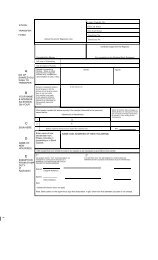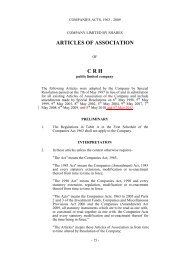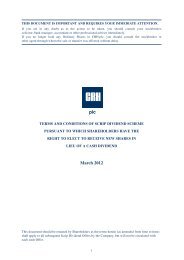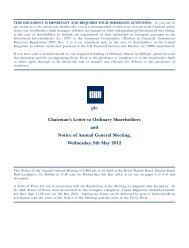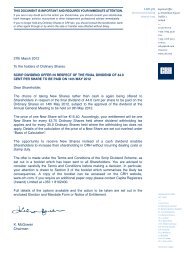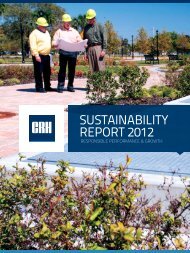2009 Annual Report - CRH
2009 Annual Report - CRH
2009 Annual Report - CRH
- TAGS
- annual
- www.crh.com
You also want an ePaper? Increase the reach of your titles
YUMPU automatically turns print PDFs into web optimized ePapers that Google loves.
Accounting Policies continued<br />
Retirement benefit obligations<br />
Costs arising in respect of the Group’s defined contribution pension schemes are<br />
charged to the Consolidated Income Statement in the period in which they are<br />
incurred. The Group has no legal or constructive obligation to pay further<br />
contributions in the event that the fund does not hold sufficient assets to meet its<br />
benefit commitments.<br />
The liabilities and costs associated with the Group’s defined benefit pension<br />
schemes (both funded and unfunded) are assessed on the basis of the projected<br />
unit credit method by professionally qualified actuaries and are arrived at using<br />
actuarial assumptions based on market expectations at the balance sheet date.<br />
The discount rates employed in determining the present value of the schemes’<br />
liabilities are determined by reference to market yields at the balance sheet date<br />
on high-quality corporate bonds of a currency and term consistent with the<br />
currency and term of the associated post-employment benefit obligations.<br />
When the benefits of a defined benefit scheme are improved, the portion of the<br />
increased benefit relating to past service by employees is recognised as an<br />
expense in the Consolidated Income Statement on a straight-line basis over the<br />
average period until the benefits become vested. To the extent that the enhanced<br />
benefits vest immediately, the related expense is recognised immediately in the<br />
Consolidated Income Statement.<br />
The net surplus or deficit arising on the Group’s defined benefit pension schemes,<br />
together with the liabilities associated with the unfunded schemes, are shown<br />
either within non-current assets or non-current liabilities on the face of the<br />
Consolidated Balance Sheet. The deferred tax impact of pension scheme<br />
surpluses and deficits is disclosed separately within deferred tax assets or<br />
liabilities as appropriate. Actuarial gains and losses are recognised immediately in<br />
the Consolidated Statement of Comprehensive Income.<br />
The defined benefit pension asset or liability in the Consolidated Balance Sheet<br />
comprises the total for each plan of the present value of the defined benefit<br />
obligation less the fair value of plan assets out of which the obligations are to be<br />
settled directly. Plan assets are assets that are held by a long-term employee<br />
benefit fund or qualifying insurance policies. Fair value is based on market price<br />
information and in the case of published securities it is the published bid price.<br />
The value of any defined benefit asset is limited to the present value of any<br />
economic benefits available in the form of refunds from the plan and reductions<br />
in the future contributions to the plan.<br />
The Group’s obligation in respect of post-employment healthcare and life<br />
assurance benefits represents the amount of future benefit that employees have<br />
earned in return for service in the current and prior periods. The obligation is<br />
computed on the basis of the projected unit credit method and is discounted to<br />
present value using a discount rate equating to the market yield at the balance<br />
sheet date on high-quality corporate bonds of a currency and term consistent<br />
with the currency and estimated term of the post-employment obligations.<br />
Share-based payments<br />
The Group operates both Share Option Schemes and a Performance Share Plan.<br />
Its policy in relation to the granting of share options and the granting of awards<br />
under the Performance Share Plan together with the nature of the underlying<br />
market and non-market performance and other vesting conditions are addressed<br />
in the <strong>Report</strong> on Directors’ Remuneration on pages 51 and 52.<br />
Share options<br />
For equity-settled share-based payment transactions (i.e. the issuance of share<br />
options), the Group measures the services received and the corresponding<br />
increase in equity at fair value at the grant date using the trinomial model. Fair<br />
value is determined on the basis that the services to be rendered by employees<br />
as consideration for the granting of share options will be received over the vesting<br />
period, which is assessed as at the grant date. The share options granted by the<br />
Company are not subject to market-based vesting conditions.<br />
The cost of equity-settled transactions is recognised, together with a<br />
corresponding increase in equity, over the period in which the performance and/<br />
or service conditions are fulfilled. The cumulative expense recognised at each<br />
reporting date until the vesting date reflects the extent to which the vesting period<br />
has expired and the Group’s best estimate of the number of equity instruments<br />
that will ultimately vest. The income statement expense/credit for a period<br />
represents the movement in cumulative expense recognised at the beginning and<br />
end of that period. The cumulative charge to the Consolidated Income Statement<br />
68 <strong>CRH</strong><br />
is reversed only where the performance condition is not met or where an employee<br />
in receipt of share options leaves service prior to completion of the expected<br />
vesting period and those options forfeit in consequence.<br />
No expense is recognised for awards that do not ultimately vest, except for<br />
equity-settled transactions where vesting is conditional upon a non-vesting<br />
condition which is treated as vesting irrespective of whether or not it is satisfied,<br />
provided that all other performance and/or service conditions are satisfied.<br />
Where an equity-settled award is cancelled, it is treated as if it vested on the date<br />
of cancellation, and any expense not yet recognised for the award is recognised<br />
immediately. This includes any award where non-vesting conditions within the<br />
control of either the Company or the employee are not met. All cancellations of<br />
equity-settled transaction awards are treated equally.<br />
The proceeds received net of any directly attributable transaction costs are<br />
credited to share capital (nominal value) and share premium when the options are<br />
exercised.<br />
The dilutive effect of outstanding options is reflected as additional share dilution<br />
in the determination of diluted earnings per share.<br />
The measurement requirements of IFRS 2 have been implemented in respect of<br />
share options that were granted after 7th November 2002. The disclosure<br />
requirements of IFRS 2 have been applied in relation to all outstanding sharebased<br />
payments regardless of their grant date.<br />
To the extent that the Group receives a tax deduction relating to the services paid<br />
in shares, deferred tax in respect of share options is provided on the basis of the<br />
difference between the market price of the underlying equity as at the date of the<br />
financial statements and the exercise price of the option; where the amount of<br />
any tax deduction (or estimated future tax deduction) exceeds the amount of the<br />
related cumulative remuneration expense, the current or deferred tax associated<br />
with the excess is recognised directly in equity.<br />
The Group has no exposure in respect of cash-settled share-based payment<br />
transactions and share-based payment transactions with cash alternatives.<br />
Awards under the Performance Share Plan<br />
The fair value of shares awarded under the Performance Share Plan is determined<br />
using a Monte Carlo simulation technique and is expensed in the Consolidated<br />
Income Statement over the vesting period. The Performance Share Plan contains<br />
inter alia a Total Shareholder Return-based (and hence market-based) vesting<br />
condition, and accordingly, the fair value assigned to the related equity instruments<br />
on initial application of IFRS 2 is adjusted so as to reflect the anticipated likelihood<br />
as at the grant date of achieving the market-based vesting condition.<br />
Property, plant and equipment<br />
Property, plant and equipment are stated at historical cost less any accumulated<br />
depreciation and any accumulated impairments except for certain items that had<br />
been revalued to fair value prior to the date of transition to IFRS (1st January<br />
2004); these items are measured on the basis of deemed cost, being the revalued<br />
amount as at the date the revaluation was performed.<br />
Depreciation and depletion<br />
Depreciation is calculated to write off the book value of each item of property,<br />
plant and equipment over its useful economic life on a straight-line basis at the<br />
following rates:<br />
Land and buildings: The book value of mineral-bearing land, less an estimate of<br />
its residual value, is depleted over the period of the mineral extraction in the<br />
proportion which production for the year bears to the latest estimates of mineral<br />
reserves. Land other than mineral-bearing land is not depreciated. In general,<br />
buildings are depreciated at 2.5% per annum (p.a.).<br />
Plant and machinery: These are depreciated at rates ranging from 3.3% p.a. to<br />
20% p.a. depending on the type of asset.<br />
Transport: On average, transport equipment is depreciated at 20% p.a.<br />
The residual values and useful lives of property, plant and equipment are reviewed,<br />
and adjusted if appropriate, at each balance sheet date.<br />
Impairment of property, plant and equipment<br />
In accordance with IAS 36 Impairment of Assets, the carrying values of items of<br />
property, plant and equipment are reviewed for impairment at each reporting date<br />
and are subject to impairment testing when events or changes in circumstances








